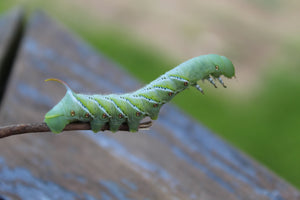Plant Nutrition, Pest Management, and Garden Watering - Cliff Notes from Class Three of the "First & Third" Fall Gardening Series
Oct 29, 2024
The content of this class is my favorite. Why do I love it so much?
Well, when you start understanding what plants need to thrive, it's easier to see the correlation to our own nutritional needs. These connections make plant care a whole lot easier.
Let's dive in, and I'll explain how!
Plant Health
First, we started with plant health because, like us, when plants are properly hydrated, get a variety of nutrients, and have strong immune systems, they are better able to fight off disease and pests.

To THRIVE, not just survive, plants need three simple aspects under control.
1. Water 2. Energy 3. Nutrition
I'll get more into water later on, but let's talk about Energy.
Energy: Plant Crops at the Right Time of the Year
We all know that plants contain the green pigment chlorophyll, which allows a plant to conduct photosynthesis and create energy from the sun. Fruit-bearing plants require even more sun power than those that do not bear fruit, which is why our fruit-bearing plants thrive during the warm months, with longer days and more hours of sunshine. For example, if you sow pumpkin seeds in November, that plant will struggle to grow those big green leaves and vines and produce healthy gourds.
Conversely, numerous vegetable plants don't want those long, warm hours of sun. They get confused and try to complete their life cycles and produce flowers and seeds, which leads to stressed plants and bitter-tasting greens.
Nutrition, the Heart of Happy Plants (and the bulk of the class)
Just as we need various nutrients to stay at the top of our game, so do our fruit and vegetable plants. There are three main Macro-nutrients (the "must haves") and three additional Micro-nutrients, also called trace elements (the "nice to haves"), that contribute to a plant's overall health throughout various lifecycles and seasons.
The Three Big Ones - NPK
Have you noticed those three numbers on the package of a box or bag of fertilizer? They indicate the percentage of each nutrient within the container.

Nitrogen (N)
The First Number represents the percentage of Nitrogen in the package.
What does this nutrient do, and why is it first? Nitrogen is incredibly important throughout a plant's lifecycle, but it is especially essential when a small seedling becomes established in its environment and rapidly growing. This macronutrient helps the plant produce chlorophyll, the green pigment in plant leaves that is critical for photosynthesis, and allows the plant to convert energy from the sun into glucose, or food for the plant!
Phosphorous (P)
The Second Number represents the percentage of Phosphorous in the package.
This nutrient strengthens roots for more water and mineral uptake. It is also incredibly important for reproduction and producing flowers, fruit, and seeds. Not to be awkward, but it helps me to remember the role of Phosporous by thinking of the "P" also to represent puberty. It's the plant going through the process of getting ready to reproduce and create the next generation.
Potassium (K)
The Third Number represents the percentage of Potassium in the package.
Potassium is important for a fruit or vegetable plant throughout its life. It keeps things flowing and, well, O-"K." It is a super transporter of nutrients to all plant parts, even getting through plant cell walls. This makes sense because this same nutrient helps humans with nutrient movement into our cells, healthy nerve function, and regulating blood pressure.
Trace Elements - Calcium, Magnesium, and Sulfur
Calcium: In the same way that it helps us build strong bones, calcium strengthens plant cell walls to grow an overall stronger and more stable plant structure.
Magnesium: Not only can it help to grow a stronger root system, but this nutrient can increase the amount of chlorophyll produced and generate more energy and food for the plant.
Sulfer: A key element for any Allium or Onion Family crop. Still, it can also aid in producing chlorophyll and help make plants more disease-resistant.
Feeding our Plants
So, how do we ensure our plants get the necessary nutrients? Here are my top tips. (We shared 12 in class, but these three should get your plants in good shape! Remember, you're reading the "Cliff Notes.")

1. Use good Organic Soil. Read what is included within your soil, including nutrients, microorganisms, material for good water retention, and material that allows for aeration.
2. Before planting, mix in Compost (either from a home or city composter, in the form of animal manure, or purchased in bags) into your soil. This will cover your main Macro and Micro Nutrients.
3. Incorporate Worm Castings (my favorite) into your soil and side-dress your plants with this magical worm poop every 2-3 weeks due to earthworms grinding gizzard and intestinal enzymes. The key nutrients are ready to be easily absorbed into your plants' roots.
Pest Control
The best pest control method is to be proactive and, therefore, less reactive. To help your plants be super resistant to pests and disease, plant crops at the right time of the year and incorporate companion planting. You can read all about that in the notes from Class 1: How to Grow a Fall Garden.

However, if you get some pesky guests, here are a few organic tips to "nip it in the bug" we shared in class.
1. Manually remove or hose off the pest. Insects, like aphids, can easily drown, and after hosing off for a few days, you can wipe out the majority of the issue.
2. If you have slugs or snails, sprinkle broken eggshells around the plants. Their soft bodies don't travel well over the sharpened soil surface.
3. Roly pollies and ants are NOT big fans of Cinnamon. Sprinkle this on the soil surface to deter these seedling-eating creatures.
Watering 411
The basics to ensure proper hydration for your plants.

1. Plant what grows in your area at the right time of year. Too much or too little water will stress the plant.
2. Plant densely. Exposed soil loses both water and nutrients. Aim to create a densely planted biodiverse area that makes a canopy of leaves to protect the soil's surface.
3. Watch the weather and keep an eye out for over-watering. If leaves look yellow, you may be watering too much. However, wilting and brown leaves may need more moisture to get to the roots.
4. Aim to water in the early mornings to give the plant what it needs for the day. Watering at night might also create an enticing damp environment for pests.
5. Water the base of the plants to help moisture reach the roots and prevent waste through evaporation.
Watering Methods
This can depend very much on where you live and the average amount of rainfall. The methods that were demonstrated are used in my own garden.
1. Hand watering. Water at the base of established plants and use a spray bottle for areas of newly sown seeds.
2. Ollas. This ancient system of irrigation is great for plants whose roots like consistent moisture. Ollas are usually clay pots buried in the soil near plants and filled with water. As the surrounding soil dries out, the moisture pulls the clay into the soil as needed.
3. Irrigation. I always recommend a drip system, such as Netafim piping, or the Garden Grid Systems by Garden in Minutes.
Self Watering Pots
At this point in class, we moved to the grass to plant Marigold and Onion self-watering pots, using the cutest ollas, and in preparation for upcoming holidays.

Thank you for reading and learning from this abbreviated version of our class.
I hope you learned a thing or two about how much we have in common with what we grow. Ultimately, by taking care of ourselves and our plants, we can handle any obstacles (even the pests) that may come our way!


